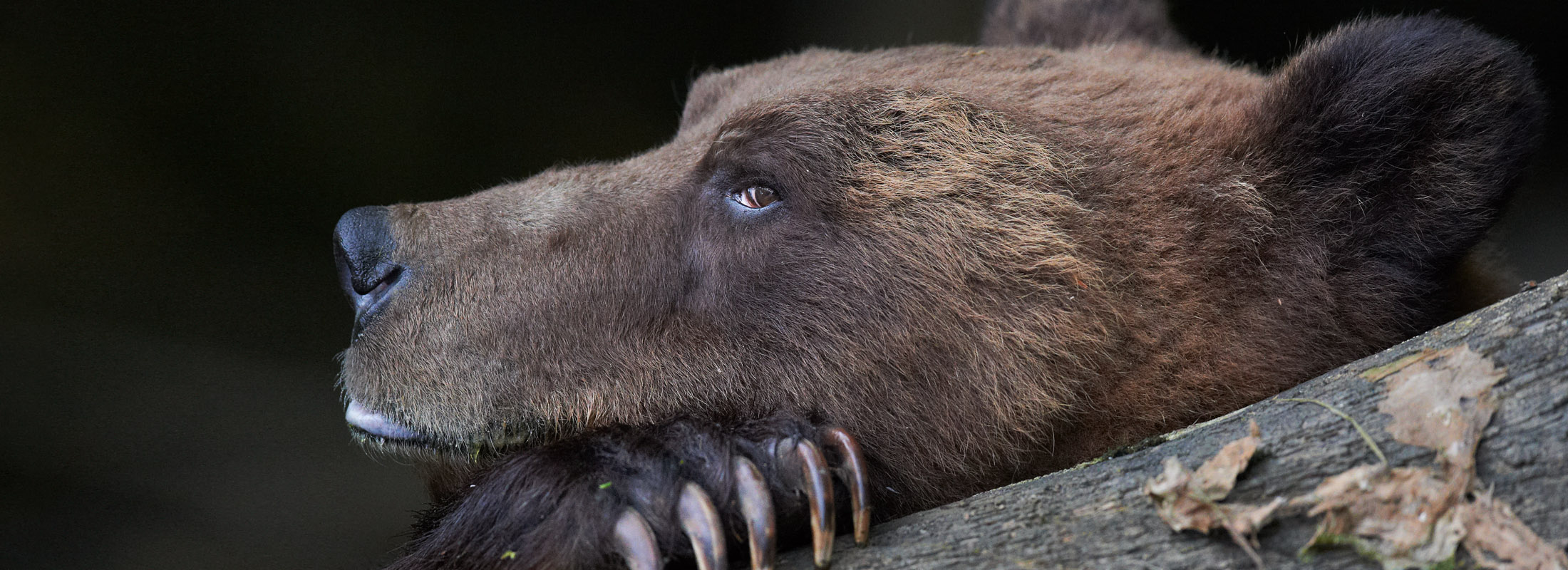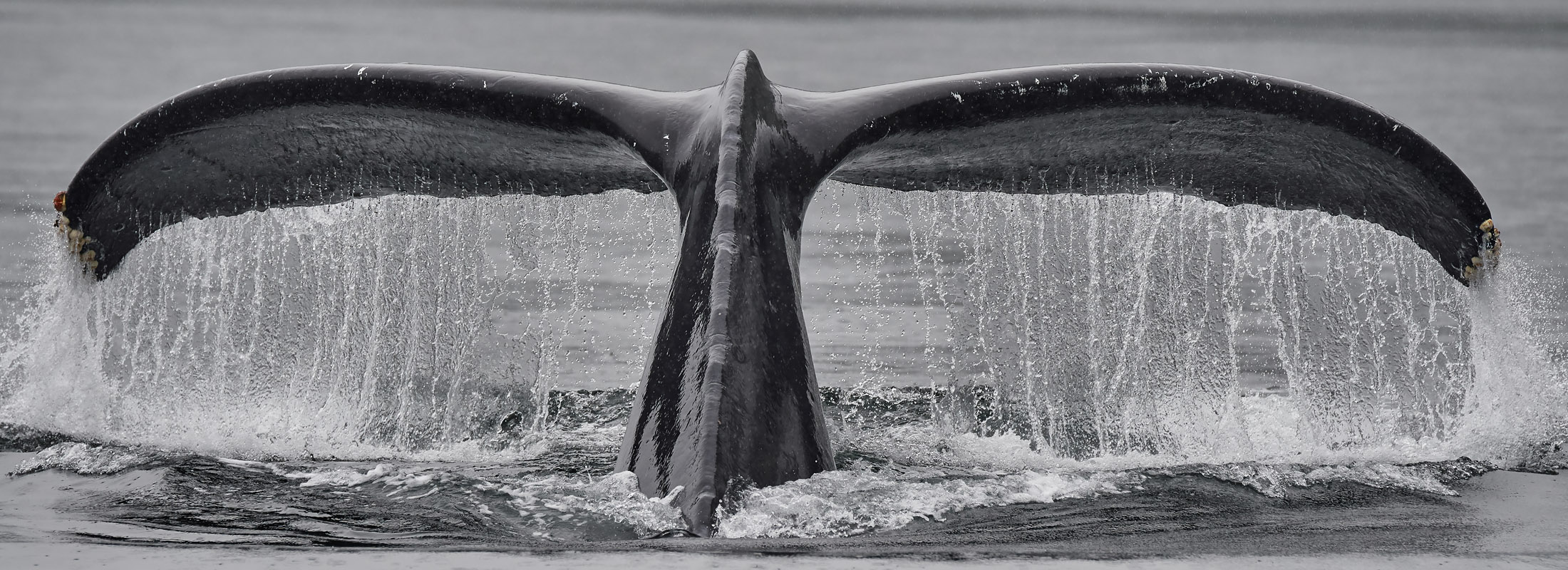The North Coast Explorer
The North Coast of British Columbia is the northern boundary of the Great Bear Rainforest. This trip aboard the Afterglow I takes you to one of the world’s most spectacular coastlines. Within the Great Bear Rainforest lie some of the world’s last pristine coastal rainforest: Old-growth hemlock and cedar forests; tidewater estuaries rich with grasses, roots and berries; cascading waterfalls and sparkling streams of spawning salmon. We will explore the outer islands, inshore inlets, bays and old-growth forests of the spectacular coast of British Columbia using the Afterglow I, the zodiac and our fleet of kayaks. The surrounding mountains and rainforest offer spectacular scenery and diverse and abundant wildlife.
Witness the rich gathering of marine mammals, sea birds and grizzly bears along the north coast of British Columbia
2024 Schedule: The North Coast Explorer
- August 3 – 10
- August 10 – 17
- August 17 – 24

- August 3 – 10
- August 10 – 17
- August 17 – 24

7 days, 7 nights
Price: $5750 plus 5% GST
Looking Ahead: The North Coast Explorer 2025
- August 2 – 9
- August 9 – 16
- August 16 – 23

- 7 days, 7 nights
- 2025 price TBD
- 2025 Brochure available: Autumn 2024
August 2 – 9 • August 9 – 16 • August 16 – 23

7 days, 7 nights • 2025 price TBD
2025 Brochure available: Autumn 2024
Background Information: Humpacks, Grizzlies and More!
Nutrient rich water from the deep, cold Pacific is funnelled into the gentler waters of Dixon Entrance and the inlets of the North Coast. Humpback whales and sea birds congregate along the coastline to feed on small fish and krill. Also in late summer salmon return to the region to spawn and attract grizzly and black bears, sea lions, wolves, and orcas.
Humpback Whales
Humpback Whales are quite abundant in the nutrient rich waters around the North Coast. Humpback whales are baleen whales that seasonally feed on tiny crustaceans, plankton and small fish. They are gulpers and therefore look for concentrated masses of prey which they can gulp in huge mouthfuls. On average a humpback whale will eat between 4000-5000 pounds of plankton, krill and small schooling fish each day in the cold waters of the north Pacific. Pacific humpbacks migrate south in the winter to give birth in the warm waters of Mexico and Hawaii.
Humpback Whales are well known for breaching and their complex songs. The name humpback whale describes the motion it makes as it arches its back out of the water then shows off its magnificent tail flukes in preparation for a dive.
Humpback Whales grow to an adult size of 17 m and weigh 40,000 kg. They can live for 45-50 years. They typically live alone or in transient small groups which come together for cooperative feeding. When the waters are super rich in nutrients many humpbacks can be seen together.
Our North Coast Explorer trip gives a small number of visitors the unique privilege of observing humpbacks and other species of aquatic mammals and marine birds over a number of days while staying on our floating base-camp Afterglow I. There’s no better, or more comfortable, way to observe and photograph these spectacular animals!
Grizzly Bear
Grizzly (or brown) bears are North America’s largest terrestrial carnivore. Size and weight vary considerably with region, but the largest bears are typically found in coastal areas. The grizzly bear gets its name from the light tipped guard hairs which give them a grizzled appearance. In the fall grizzlies emerge from the forest and focus on eating spawning salmon in the creeks and rivers. They can also be seen foraging in the intertidal zone for clams and shore crabs. Coastal grizzly bears are powerful swimmers and in their estuary home are in and out of the water almost constantly. They can often be seen snorkelling with just their heads below the water.
On the coast grizzly bears enter their dens to hibernate in late October/early November, and cubs are born in the dens in the deep of winter. Typically the bears emerge from the dens in early spring. Female grizzlies on the coast have between 1 and 3 cubs.
Grizzly bears have a great sense of smell and phenomenal hearing. Contrary to folklore, grizzlies can also see very well and their vision is comparable to humans. They use their powerful senses to locate food and to detect danger.
We find that the best time period for viewing grizzlies in the Khutzeymateen is from mid-May through to mid-June and then again mid August. During this time the bears are normally present in relatively large numbers and exhibit (and share with us) an amazingly wide array of behaviours, fishing, dominance struggles between young males and their older counterparts, mother-cub interactions, and more.
Travelling to the beautiful Khutzeymateen Valley and sharing a few days with the grizzlies of the Khutzeymateen is a unique and unforgettable experience that you will cherish forever.
FAQs about our North Coast Explorer
All of our tours offer excellent photographic opportunities. Our photography tours are very similar to our standard tours but to accommodate the additional gear of photographers – and to maximize shooting angles from our inflatable boat – they are limited to fewer participants (normally 6 clients plus the photography guide).
Yes we request that you stay within the suggested weight limits. We choose to use float planes to transport our guests to and/or from the boat but the planes have weight restrictions. Our fresh food is also brought in on the float planes. The Afterglow I, while being spacious, is still a boat and storage space for extra gear is always limited. Please follow the list of suggested clothing and equipment carefully and remember your stay on board is just 3 or 7 days. If your gear exceeds the weight limit it may get left behind or you may be charged for an extra float plane!
Yes, there are drying lockers on the aft deck where we hang all the wet gear each night to dry. In order to keep the inside of the boat dry and comfortable we do not bring wet gear into the main living area or cabins. Cotton clothing is not recommended as it takes a long time to dry.
No, there are not opportunities for kayaking on all our trips. Our Gwaii Haanas trips offer the best kayaking experiences as there are many different bays and coastlines waiting to be explored by kayak. Our North Coast Explorer trips also offer sheltered kayaking while the Afterglow I is at anchor.
Yes. In Gwaii Haanas and North Coast Explorer we will try fishing for halibut, lingcod, and salmon as well as crabs, when possible. On our Khutzeymateen and Great Bear Rainforest trips we will try fishing for Dungeness crabs and, if opportunities present themselves, for salmon and halibut. If you want to participate in fishing you must purchase a saltwater fishing license before you arrive at the boat.
Please do not bring a tripod on our Khutzeymateen trips, there will be no opportunity to use it as all shooting is done from the inflatable and it is too heavy to bring on the float plane. On all other trips, you can bring a tripod and it may be useful in certain situations. Note that on many of our trips we follow the bears’ daily activities and therefore move about quite a lot- a beanbag can be useful when shooting from the zodiac. On the Great Bear Rainforest trips, we utilize bear viewing stands on the edge of the river and tripods will be useful. On the North Coast Explorer trip it is good to have a tripod to set up on the deck of the Afterglow I to photograph the various marine mammals.
Yes, the boat has a number of regular household outlets for charging batteries. Other electrical appliances such as hair dryers can be used but may need the generator so check with the crew before using.
Yes, you can bring a laptop. The boat has an inverter with 120V AC power at all times. Remember we have strict weight limits on the float planes so choose your gear wisely.
Ocean Light Adventures offers trips that are fantastic for families. We are a family run company and are always willing and excited to get family groups on board. Gwaii Haanas National Park on Haida Gwaii and the North Coast Explorer are amazing family destinations because of the variety of activities available and the small distances needed to travel. As well, the wildlife is incredible and the opportunities for active pursuits such as kayaking, hiking, fishing and exploring are unsurpassed.
Our absolute maximum group size is 9, however we prefer to run trips with 6-8. This small group size is favourable because it creates a more intimate setting and makes it easier to move as a group.
Within the Khutzeymateen Sanctuary bear viewing guidelines have been set up. We must follow the guidelines and approach the bears to within safe distances. We will get ample opportunities to view and photograph the bears from a favourable distance. On our Great Bear Rainforest trip, we will explore grizzly habitat in the inflatable and are governed by BC Parks and First Nations guidelines. For our spirit bear viewing we observe the bears from a stand set up on the edge of the river.
No, we do not charge a single supplement. However you will most likely have to share a cabin (two separate bunks) with another guest of the same gender, or you may be lucky and get a cabin to yourself, it all depends on the make-up of the other guests.
Ocean Light Adventures has been in operation on the BC Coast for over 30 years and our experience and expertise in the areas that we visit is unsurpassed. We keep our groups small and intimate so that we can move about in our wilderness settings more efficiently and safely. Our boat, the Afterglow I is a beautiful, spacious and comfortable yacht and it is expertly maintained and fully equipped. We have passionate, experienced, professional crew who will make sure your trip is an amazing one.














